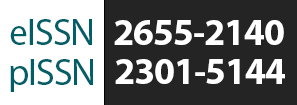Papuan Batik Dissemination through Documentary Videos (Case Study on Phokouw Faa Batik Center)
DOI:
https://doi.org/10.33375/vslt.v8i1.1774Keywords:
Batik, Documentary, Information, Papua, Phokouw FaaAbstract
Papuan batik is batik originating from the Province of Papua, Indonesia. The batik was produced by the Phokouw Faa batik center in Papua Province. The batik center of Phokouw Faa realizes that the batik that he manufactures is not evenly recognized in Papua Province, so that efforts are needed to inform the existence of the Papua batik. The method used in this research is an experiment on the application of elements and principles of visual communication design using non-conventional media (non-print), namely on time-based digital media in the form of documentary videos. Data to design a visual communication about Papuan batik was obtained during a field survey by observing and interviewing. The identities of the Papua province were applied in developing the documentary video. The full results of the research can be seen on the Youtube link as follow https://youtu.be/M5EP0b3jaBs.
Downloads
Downloads
Published
Issue
Section
License
Authors who publish with Visualita agree to the following terms:
- Authors retain copyright and grant the journal right of first publication with the work simultaneously licensed under a Creative Commons Attribution-NonCommercial 4.0 International License.
- Authors are able to enter into separate, additional contractual arrangements for the non-exclusive public distribution and display of the journal's published version of the work (e.g., post it to an institutional repository or publish it in a book), with an acknowledgement of its initial publication in this journal.
- Authors wishing to include items (such as images or other media, or any creative works of others whether previously published or not) must contact the original copyright holder to obtain explicit permission to publish these items in Visualital. Writing permission should include: the title(s) of any copyrighted work, original place of publication if applicable, and an acknowledgement of having read Visualita copyright notice. Authors are responsible for obtaining this permission and keeping it in their own records for later verification.






